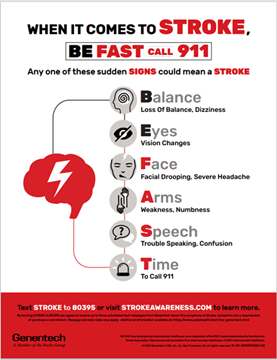What is a Stroke?
A stroke occurs when the brain is deprived of sufficient blood flow, interrupting the delivery of necessary oxygen and nutrients.
There are two main types of strokes:
- Ischemic, which involves a blockage in an artery supplying blood to the brain
- Hemorrhagic, which results from a ruptured blood vessel in or on the brain
- There are also transient ischemic attacks (often called “mini-strokes”) that resemble strokes but last for a much shorter period of time, resolve spontaneously and generally do not cause permanent damage to the brain.
A stroke is a medical emergency, as brain cells begin to die in minutes and prompt treatment is crucial. Early action can reduce brain damage and other complications.
What are the Signs of a Stroke?
Any one of these sudden signs could mean a Stroke. Remember the acronym BE FAST so you can recognize stroke and call 911:
- Balance - Watch for sudden loss of balance
- Eyes - Check for vision loss
- Face - Look for an uneven smile
- Arm - Check if one arm is weak
- Speech - Listen for slurred speech
- Time - Call 911 right away

Image source: Genentech, "BE FAST Poster Handout" 2021. Accessed via https://www.strokeawareness.com/patient/spread-the-word.html.
Both ischemic and hemorrhagic stroke and transient ischemic attacks share many of the same signs and symptoms, such as:
- Drooping or numbness of the face, typically only on one side
- Weakness of the arms and/or legs, usually on one side of the body
- Slurred speech
- Confusion or difficulty comprehending speech
- Severe headache
- Numbness
- Confusion
- Dizziness or loss of balance
These symptoms typically come on suddenly, and they require immediate medical attention. If you think you’re having a stroke, call 911.
What Causes a Stroke?
There are two main causes of stroke: a blocked artery (ischemic stroke) or the leaking or bursting of a blood vessel (hemorrhagic stroke). The underlying causes of stroke, however, are often multifaceted and may include risk factors that are beyond the control of the patient (such as being over the age of 55), as well as controllable lifestyle choices that include being a smoker or using illicit drugs. Risk factors for stroke include:
Diabetes is an endocrine disorder in which your body builds up too much blood sugar.
TGH offers courses to assist people living with diabetes. Visit the links below to register for a course:
High blood pressure, also known as hypertension, happens when the force of your blood pushing against the walls of your blood vessels is too high. High blood pressure can lead to other serious problems such as heart attack and stroke.
TGH offers the following courses to help you monitor and manage high blood pressure:
Atrial fibrillation (AFib) is the most common type of arrhythmia (abnormal heartbeat). Causes of atrial fibrillation can range from heart defects or abnormalities to unexplained causes, but those living with AFib are five times more likely to suffer a stroke.
TGH hosts a support group for AFib patients. Learn more about this group and sign up at the link below:
Sedentary lifestyles and poor nutrition can lead to stroke. Exercise and healthy eating are key to maintaining a healthy heart.
TGH offers several courses to help you live well. Sign up at the links below:
Smoking and alcohol consumption can cause harmful effects to your body that lead to stroke.
TGH offers several course to help you quit smoking and manage alcohol consumption:
Atherosclerosis is a gradual, lifelong progression of changes in blood vessels. In many cases, atherosclerosis goes undiagnosed until it causes a life-threatening heart attack or stroke.
How is a Stroke Diagnosed?
When you arrive at the hospital, multiple tests will be quickly performed to rule out other possible causes of your symptoms and determine which type of stroke you’re having. These tests include:
- A physical exam
- Blood tests
- Computerized tomography (CT) scan
- Magnetic resonance imaging (MRI)
- Carotid ultrasound
- Cerebral angiogram
- Echocardiogram
How is a Stroke Treated?
Emergency treatment for stroke depends on whether you're having an ischemic stroke (blocked artery) or a hemorrhagic stroke (bleeding into the brain).
Treatment for ischemic strokes can include:
- Emergency IV medication
- Emergency endovascular procedures
- Carotid endarterectomy
- Angioplasty and stents
Treatment options for hemorrhagic strokes include:
- Emergency measures
- Surgery
- Coiling (endovascular embolization)
- Stereotactic radiosurgery
Why Choose Tampa General's Comprehensive Stroke Center?
As one of the only Comprehensive Stroke Centers in Tampa, TGH is prepared to immediately respond to any emergent signs of a stroke with board certified neurologists, advanced neuro-imaging, and complex neurosurgical interventions. Tampa General's 32-bed Neurosciences Intensive Care Unit is one of the largest in the country.
Tampa General Hospital was named in the Top 10% in the Nation for Neurology & Neurosurgery and "High Performing" for Stroke Care, according to U.S. News & World Report for 2024-25. TGH is also recognized as Honor Role Elite Gold Plus for Stroke Care by the American Heart Association.
Stroke Resources
Interested in learning more about stroke and finding ways to manage your risk factors? Visit the resources below, presented by TGH and our partners:
- Stroke Support Group
- Preventing Stroke As We Age
- Hillsborough County Healthy Living Program
- Resource Library | American Stroke Association
- TampaWell
- American Stroke Association


